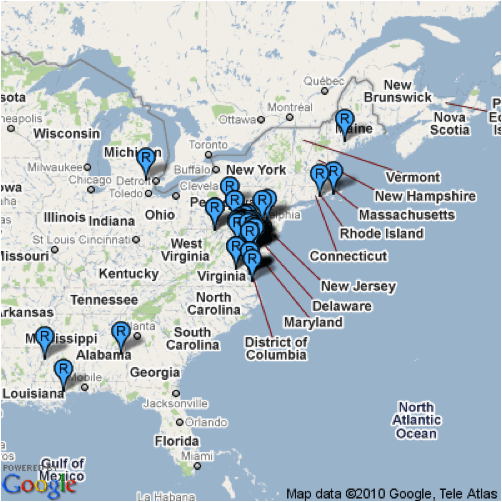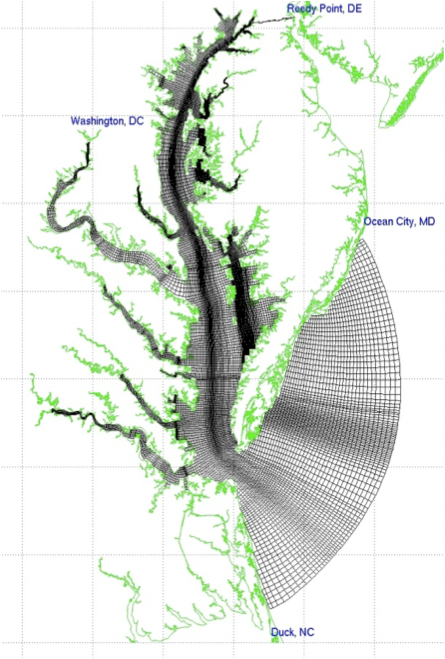Chesapeake Community Modeling Program
the CCMP Newsletter | March 2010
Volume 3, Issue 1
Introduction
Greetings! CCMP is excited to begin the third year of publishing this newsletter. Over the past two years we have strived to be a source for information related to open source modeling, computing and software as well as keep you informed about related events and opportunities around the Chesapeake Region. We hope that you have found the Newsletter useful and informative. Please drop us a line (dave@communitymodeling.org) and let us know what you think.

Contents
1. CCMP News in brief
2. News from other communities
3. Open Source on the March
4. Featured Modeler: Elizabeth North
5. Featured Model: CBOFS2
1. CCMP News in Brief
Chesapeake Modeling Symposium 2010 – May 10-11, 2010
 ChesMS10 is shaping up to be a very exciting and informative event with over 100 presentations on topics ranging from shallow water modeling to ecological forecasting to coping with modeling uncertainty. As you can see from the map of registrants, people will be attending from all over the Chesapeake Basin as well as from all around the eastern half of the United States.
ChesMS10 is shaping up to be a very exciting and informative event with over 100 presentations on topics ranging from shallow water modeling to ecological forecasting to coping with modeling uncertainty. As you can see from the map of registrants, people will be attending from all over the Chesapeake Basin as well as from all around the eastern half of the United States.
As mentioned in the last Newsletter, EPA’s Chuck Fox will be giving the Keynote address on the morning of Day 1 followed by Plenary talks by Kenneth Reckow of Duke University, Robert Hirsch of USGS and Christoph Homberg of the Baltic NEST Institute. Please note that the cut-off date for both early registration and the group hotel rate is March 31. After this date, registration will increase from $180 to $210 and the nightly hotel rate (Doubletree Annapolis) from $119 (plus tax) to $149 (plus tax) so register now and save.
Go to here to find more information on registering for the event and hotel reservations. You can also take a look at the symposium schedule and browse through the presentation titles.
Regional Model Comparison: Mixing/Vertical Stratification in Chesapeake Bay
A number of modelers from the region are currently conducting runs of multiple Chesapeake Bay hydrodynamic models using common data input for the period 2003-2005. The goal is to compare model output of vertical distributions of salinity and temperature versus field observations for specific stations/locations and times (well mixed late winter, stratified summer, and possibly mixed fall). The results will be presented at the May CheMS'10 meeting in a special 1/2 day session to identify models best approximating vertical distributions of salt and temperature, as these are critical to maximizing future biogeochemical modeling estimates of dissolved oxygen in the stratified bay, the governing factor in summer estimates of nutrient fluxes, productivity, and living resource distributions. Possible models in the suite include three versions of ROMS, plus CH3D, SELFE, and ELCIRC, with others likely in the future. Results will also inform future discussions of single model implementation for application in the bay or ensemble modeling to best approximate ambient conditions. Contact Wen Long (wenlong@umces.edu) for additional information.
CCMP Steering Committee Meeting
 The next CCMP Steering Committee meeting is scheduled for 12 pm on May 17th at the Smithsonian Environmental Research Center. The current membership of the CCMP SC includes: Raleigh Hood (chair), Bill Ball, Chris Duffy, Claire Welty, Gary Shenk, Doug Wilson, Barry Stamey, Kevin McIlhany, Don Weller, Carl Friedrichs and Alexey Voinov, with Kevin Sellner and Dave Jasinski attending as representatives of the CRC and the CCMP. Participation in this meeting is open and encouraged. If you would like to attend, please contact Raleigh Hood (rhood@umces.edu).
The next CCMP Steering Committee meeting is scheduled for 12 pm on May 17th at the Smithsonian Environmental Research Center. The current membership of the CCMP SC includes: Raleigh Hood (chair), Bill Ball, Chris Duffy, Claire Welty, Gary Shenk, Doug Wilson, Barry Stamey, Kevin McIlhany, Don Weller, Carl Friedrichs and Alexey Voinov, with Kevin Sellner and Dave Jasinski attending as representatives of the CRC and the CCMP. Participation in this meeting is open and encouraged. If you would like to attend, please contact Raleigh Hood (rhood@umces.edu).
2. News From Other Communities
MOU for Standards for Environmental Modeling

 A memorandum of Understanding has been signed between the Open Geospatial Consortium (OGC) and the International Environmental Modeling and Software Society (iEMSs). The MOU is focused on the need for interoperable web based geospatial technologies in environmental modeling software. The goal of this collaboration is to develop new technologies that will help to integrate environmental models. Alexey Voinov is president of iEMSs and also a CCMP Steering Committee member.
A memorandum of Understanding has been signed between the Open Geospatial Consortium (OGC) and the International Environmental Modeling and Software Society (iEMSs). The MOU is focused on the need for interoperable web based geospatial technologies in environmental modeling software. The goal of this collaboration is to develop new technologies that will help to integrate environmental models. Alexey Voinov is president of iEMSs and also a CCMP Steering Committee member.
EPA and OpenMI
 At the OpenMI-Life Workshop (January 11-12) in Brussels, the US Environmental Protection Agency announced that they will adopt the OpenMI standard in their integrated modeling activities. OpenMI provides a standard interface that allows models to communicate. OpenMI compliant models can exchange information at run-time.
At the OpenMI-Life Workshop (January 11-12) in Brussels, the US Environmental Protection Agency announced that they will adopt the OpenMI standard in their integrated modeling activities. OpenMI provides a standard interface that allows models to communicate. OpenMI compliant models can exchange information at run-time.
3. Open Source on the March
An Open Source Way of Life
 Red Hat, the folks who brought us the Linux operating system, is attempting to expand the open source philosophy beyond the computing world with their new website opensource.com. Here, they apply what they refer to as the “Open Source Way” to issues in Business, Education, Government, Law and Life through opinion articles . The Open Source Way is centered on five central beliefs: open exchange, the power of participation, rapid prototyping, meritocracy, and community. Opensource.com cites a few examples of the open source method applied in Society (Wikipedia), Business (Whole Foods), Government (the Obama Administration) and Education (MIT OpenCourseWare).
Red Hat, the folks who brought us the Linux operating system, is attempting to expand the open source philosophy beyond the computing world with their new website opensource.com. Here, they apply what they refer to as the “Open Source Way” to issues in Business, Education, Government, Law and Life through opinion articles . The Open Source Way is centered on five central beliefs: open exchange, the power of participation, rapid prototyping, meritocracy, and community. Opensource.com cites a few examples of the open source method applied in Society (Wikipedia), Business (Whole Foods), Government (the Obama Administration) and Education (MIT OpenCourseWare).
Check out the site for some interesting perspectives on topics ranging from music sharing to politics.
Get a Free Robot

If you’ve ever dreamed of having your very own robot, your chance may be here. Robotics designer Willow Garage will be giving away 10 of their PR2 robots to software developers who agree to share their programs with the open source community. Willow Garage was founded on creating an open source robotics platform. They are targeting research labs with the free robot campaign in the hopes that students will get hands-on experience. Interested parties need to submit a letter of intent followed by a full proposal by March 1.
Check out the Willow Garage website for full details as well several videos of the PR2 in action.
4. Featured Modeler: Elizabeth North
 Horn Point Laboratory
Horn Point Laboratory
University of Maryland Center for Environmental Science
P.O. Box 775
Cambridge, MD 21613
website
- B.A., Swarthmore College
- M.S. Johns Hopkins University
- Ph.D., University of Maryland College Park
Elizabeth received her B.A. from Swarthmore College, M.S. from Johns Hopkins University and Ph.D. from the University of Maryland College Park. Elizabeth is currently an Assistant Professor at Horn Point Laboratory, University of Maryland Center for Environmental Science. Her research interests are focused on biological and physical interactions: Circulation and particle trajectory modeling, fish larvae and zooplankton ecology, fisheries population variability and estuarine and coastal physical oceanography. Elizabeth’s technical approach involves fieldwork and numerical modeling and their intersection in the development of predictive models to help improve management of marine resources.
Among her many accomplishments has been the development of the Larval TRANSport Lagrangian model (LTRANS), an open-source off-line particle tracking model that runs using stored circulation and mixing fields from 3-dimensional circulation models (see our featured model in the April 2009 Issue of the CCMP Newsletter). Elizabeth has also recently developed a coupled optimization/ecological model decision support tool for oyster restoration management in Chesapeake Bay. Her current research efforts include studies of larval transport between the Chesapeake and Delaware Bays and shelf waters, which includes research aimed at understanding how physical conditions and megalopae behavior affect blue crab recruitment. Elizabeth also has research projects focusing on the zooplankton and fish interactions in the Chesapeake Bay ETM and modeling hypoxia and ecological responses to climate change and anthropogenic effects in Chesapeake Bay.
Although Elizabeth’s research efforts have been focused primarily on Chesapeake Bay, Delaware Bay and the adjacent shelf region, she has been engaged in research activities and program oversight at both the national and international levels: Elizabeth is a member of the US Global Ocean Ecosystem Dynamics (GLOBEC) Program Scientific Steering Committee and a member of the International Council for the Exploration of the the Seas (ICES) Working Group on Modeling Physical-Biological Interactions.
5. Featured Model: The NOAA/NOS Chesapeake Bay Operational Forecast System (CBOFS2)

This artical contributed by Dr. Lyon Lanerolle, NOAA Ocean Service
There currently exists an Operational Forecast System (OFS) for the Chesapeake Bay (CBOFS), which routinely generates model-derived nowcasts and forecasts of water elevation. It is maintained and run by the NOAA/NOS/Center for Operational Oceanographic Products and Services (CO-OPS). However, this model is two-dimensional and barotropic in nature and it was recently decided to upgrade the OFS with a fully three-dimensional system.
The three-dimensional CBOFS upgrade, CBOFS2, was developed at NOAA/NOS/Office of Coast Survey (OCS)/Coast Survey Development Laboratory (CSDL) using Rutgers University’s Regional Ocean Modeling System (ROMS). The model grid consists of 291 x 332 grid points in the horizontal and 20 terrain following σ-levels in the vertical. The horizontal grid was designed to follow the tributaries entering the bay and the deep, narrow channels as closely as possible with the given number of grid points. The computational domain and model grid are shown in the image to the right.
The model is forced at the surface using meteorological variables which yield wind stresses and a net heat flux via the ROMS Bulk Flux formulation. At the bottom, a quadratic momentum stress is applied. Along the open ocean boundaries, water elevation, temperature and salinity forcing is employed; at the C & D canal exit to Delaware Bay, the forcing is further refined by including the along-axis barotropic current component in order to account for the flow within the canal better. Eighteen rivers are included in the CBOFS2 modeling set-up.
During the development phase of CBOFS2, a synoptic hindcast simulation spanning 27-months (June 01, 2003 to August 31, 2005) was performed and the model predictions for water elevations, currents, temperature and salinity were evaluated against observed data. The evaluation process also included the employment of the NOAA/NOS skill assessment software.
CBOFS2 is presently running in a real-time, quasi-operational fashion in a MPI-parallelized environment on the NOAA/National Weather Service (NWS)/National Centers for Environmental Prediction (NCEP) supercomputer cluster generating four daily forecasts. It is expected to become fully operational by the summer of 2010. The output fields of CBOFS2 (water elevations, currents, temperature and salinity) are expected to be useful to the marine navigation, emergency response, ecological modeling/forecasting and the general scientific communities.
Chesapeake Community Model Program
http://ches.communitymodeling.org/
Chesapeake Research Consortium
Edgewater, MD
410-798-1283